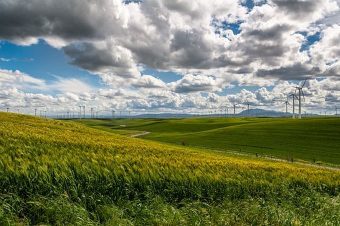
In 19 years, Ramu Gaviti’s six acres of land have gone from barren, dry and sparsely vegetated to fertile, moist and thick with biomass. Peacocks, wild pigs and rabbits have reappeared and in rejuvenated rivers, boys trap fish in baskets.
Gaviti once scratched $29 (£23) worth of millet and grass per acre per year. In bad years he left his smallholding in Jawhar, in the hills to the north-east of Mumbai, and went to mine sand at the coast for construction. “Sometimes you feel as if you can go in the river and drown,” said the farmer, who has heard of 50 men who never returned. Now he has more than 1,000 fruit, nut and forest trees, paddy rice, a tractor, a brick house, and an income the equivalent of $1,200 (£975) a year.
Gaviti’s life has been transformed by a model of agroforestry pioneered by an Indian NGO. “If the organisation had not come, we would have had no guiding person,” he says. The NGO BAIF, who specialise in supporting climate-resilient agriculture, arrived in 1997 and worked closely with local people until 2004. “It was a wasteland virtually,” says agriculturalist Sudhir Wagle, who led the effort. “We began by suggesting 40-60 mango and cashew trees per acre and a boundary of indigenous trees. Including costs such as development of common water sources, we calculate that each acre cost us $130 [£105] a year to improve and that it took us and the farmers five years. But we saw families getting $225 [£180] per acre a year after five years and $670 [£545] per acre a year after ten.”
Gaviti and his fellow farmers are more than an economic success, however. They are a climate success too. Agriculture is the world’s second largest emitter of gases such as CO2 that cause climate change. But the villagers’ trees have been drawing carbon from the atmosphere for years. This represents one of the greatest hopes for India, which has committed to capture 2.5 to 3bn tonnes of carbon through new tree and forest cover by 2030, to deliver on the Paris accord.
“The vast majority of India is agricultural land,” says World Agroforestry Centre’s Dr Ravi Prabhu. “We can deliver from this landscape and help people at the same time. Agriculture finds no mention in the accord. The focus is forests. But agriculture accounts for 10-12% of emissions and 70% of biodiversity loss and fresh water use. We cannot afford to segregate or we will be left with islands of biodiversity surrounded by deserts.”
Turning agriculture into a carbon sink is not a dream. Scientists from the World Agroforestry Centre, Royal Botanic Garden Edinburgh, and elsewhere found that agricultural land can hold four times as much carbon as previously estimated by the Intergovernmental Panel on Climate Change. The US Environmental Protection Agency states that, while fossil fuel use is the primary source of CO2: “The way in which people use land is also an important source, especially when it involves deforestation.” Likewise, land can remove CO2 from the atmosphere through reforestation and improvement of soils.
Scaling up what Gaviti and the other villagers are doing could be one of India’s greatest hopes for delivering on its commitments to the Paris agreement on climate change.
India’s government recognised the value of trees on farms in 2014 with the world’s first national agroforestry policy (pdf), which aims to help increase forest or tree cover to 33% from the present 21%. A key impetus was timber; farm trees meet 65% of India’s demand. The policy could put India leagues ahead on climate change and save land from ruination: 50% of India’s land is degraded and 86% of the degraded land is agricultural, says World Resources Institute’s Dr Nitin Pandit.
Rakesh Sinha, joint secretary in the Ministry of Agriculture, is in charge of rolling out the plan. “Trees have always been part and parcel of Indian agriculture but now we are considering paying farmers for ecological services from agroforestry.”
Back in Jawhar, Gaviti tends his trees, among the many fruits of which have also been a change in social status. “When I go to town, they don’t disrespect me for being a labourer“. Bowing his head and putting his hands together, he says: “They now say Namaskar.”
Source: theguardian.com



